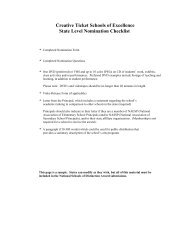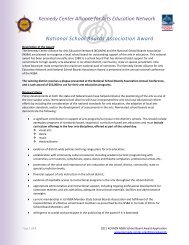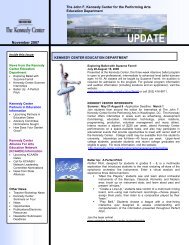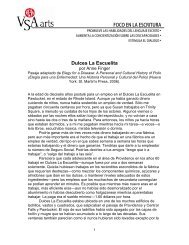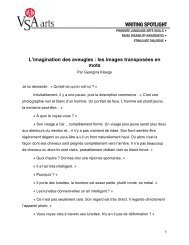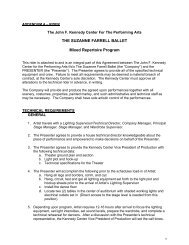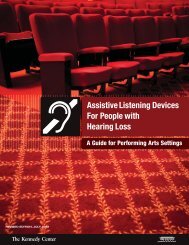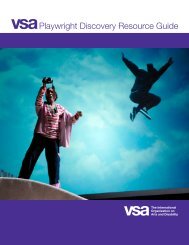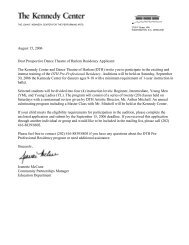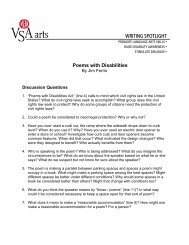draft of 05-19-08 - The John F. Kennedy Center for the Performing Arts
draft of 05-19-08 - The John F. Kennedy Center for the Performing Arts
draft of 05-19-08 - The John F. Kennedy Center for the Performing Arts
You also want an ePaper? Increase the reach of your titles
YUMPU automatically turns print PDFs into web optimized ePapers that Google loves.
** DRAFT OF <strong>05</strong>-<strong>19</strong>-<strong>08</strong> **<br />
Current Issues and Evidence Based Practices<br />
In Inclusion <strong>of</strong> Children with Disabilities in Early Childhood Education<br />
Introduction<br />
This document is submitted in partial completion <strong>of</strong> <strong>the</strong> contract between VSA arts and SPEC<br />
Associates to conduct a research study <strong>of</strong> Start with <strong>the</strong> <strong>Arts</strong> and literature review <strong>of</strong> empirical<br />
research related to <strong>the</strong> use <strong>of</strong> arts in teaching preschool literacy and related to best practices in<br />
<strong>the</strong> inclusion <strong>of</strong> children with disabilities in early childhood education.<br />
<strong>The</strong> purpose <strong>of</strong> this review is to provide updated in<strong>for</strong>mation about current best practice thinking<br />
and research related to <strong>the</strong> inclusion <strong>of</strong> children with disabilities when doing art in early<br />
childhood settings. No research was found specifically related to including children with<br />
disabilities in pre-school art instruction. While literature was found related to inclusion with<br />
children with specific disabilities, review <strong>of</strong> <strong>the</strong>se studies was beyond <strong>the</strong> scope <strong>of</strong> this review.<br />
<strong>The</strong> focus <strong>of</strong> this review was on general principles and practices related to inclusion in settings<br />
involving children ages 0 through 8.<br />
Methods<br />
This review began with resource documents already known to <strong>the</strong> content expert <strong>for</strong> this project,<br />
Dr. Shannan McNair, Ed.D. at Oakland University, a Pr<strong>of</strong>essor <strong>of</strong> Early Childhood Education.<br />
Dr. McNair’s resources were augmented by a published literature search using three online<br />
search engines: (1) ERIC, (2) Education Abstracts, and (3) PsychInfo. 1<br />
<strong>The</strong> following search terms were used in <strong>the</strong> online search:<br />
Inclusion, Early Childhood, <strong>Arts</strong>, Preschool, Disabilities<br />
Documents were selected <strong>for</strong> review if <strong>the</strong>y were:<br />
a. Relevant to early childhood (ages 0 through 8 years)<br />
b. Related to <strong>the</strong> inclusion <strong>of</strong> children with disabilities<br />
<strong>The</strong> abstracts <strong>of</strong> selected articles and book chapters were reviewed and fur<strong>the</strong>r screened <strong>for</strong>:<br />
a. Publication date as 2000 or later<br />
b. Being an empirical study or a review <strong>of</strong> empirical studies<br />
In our search <strong>for</strong> <strong>the</strong> literature we identified <strong>the</strong> book entitled:<br />
Guralnick, M.J. (Ed.) (2001) Early childhood inclusion: focus on change. Baltimore: Paul<br />
H Brookes Publishing Co.<br />
1 <strong>The</strong> original plan also called <strong>for</strong> <strong>the</strong> use <strong>of</strong> GoogleScholar as a search engine. However, it was believed that <strong>the</strong><br />
three search engines listed above encompass all <strong>of</strong> <strong>the</strong> major scholarly work in this area and that GoogleScholar<br />
would yield redundant in<strong>for</strong>mation.<br />
SPEC Associates <strong>for</strong> VSA arts Page 1 <strong>of</strong> 12<br />
Literature Review: Inclusion
** DRAFT OF <strong>05</strong>-<strong>19</strong>-<strong>08</strong> **<br />
A review <strong>of</strong> this book revealed that it was very comprehensive in its coverage <strong>of</strong> research studies<br />
on inclusion in early childhood education. With permission from <strong>the</strong> director <strong>of</strong> evaluation at<br />
VSA arts, we focused this review on relevant chapters <strong>of</strong> this book.<br />
One additional article was also identified as relevant and was reviewed:<br />
Cross, A.F., Traub, E.K, Hutter-Pishgahl, L. and Shelton, G. (2004) Elements <strong>of</strong><br />
successful inclusion <strong>for</strong> children with significant disabilities. Topics in Early Childhood<br />
Special Education, 24 (3) pp. 169-183.<br />
Findings<br />
<strong>The</strong> issues and practices summarized here are those that <strong>the</strong> reviewers believed are relevant<br />
specifically to <strong>the</strong> use <strong>of</strong> Start with <strong>the</strong> <strong>Arts</strong> with children at home or in early childhood<br />
education settings.<br />
Current Issues Related to Inclusion <strong>of</strong> Children with Disabilities<br />
Our review identified <strong>the</strong> following issues being discussed by researchers related to inclusion <strong>of</strong><br />
children with disabilities in early childhood education:<br />
Current philosophical thinking is that inclusive settings are superior, <strong>of</strong>fering children a<br />
more effective way to prepare <strong>for</strong> <strong>the</strong> real world, friendships with typically-developing<br />
children, and <strong>the</strong> opportunity to play, share toys and cooperate with o<strong>the</strong>rs.<br />
<strong>The</strong>re is a paucity <strong>of</strong> research on what factors predict <strong>the</strong> successful inclusion <strong>of</strong> children<br />
with disabilities in early childhood education program. <strong>The</strong> research that has been<br />
conducted does not provide clear evidence that inclusive environments are any better than<br />
segregated environments in yielding developmental outcomes <strong>for</strong> children with<br />
disabilities.<br />
Current philosophical thinking is that inclusive interventions should be child-centered<br />
with outcomes expected not only <strong>for</strong> <strong>the</strong> child, but also <strong>for</strong> <strong>the</strong> family.<br />
Most research on inclusion has been conducted with children <strong>of</strong> preschool age; little<br />
research has been done on inclusion with infants and toddlers.<br />
Most children who have disabilities are served in <strong>the</strong>ir homes.<br />
Most child care settings in <strong>the</strong> U.S. are not fully inclusive.<br />
<strong>The</strong>re are many o<strong>the</strong>r goals <strong>for</strong> inclusion besides development, such as: (a) promoting<br />
group membership, (b) promoting social relationships, (c) promoting functional skill<br />
competence, (d) increasing acceptance by o<strong>the</strong>rs, (e) increasing <strong>the</strong> chances <strong>of</strong> o<strong>the</strong>rs<br />
interacting with <strong>the</strong> child, (f) increasing <strong>the</strong> degree to which <strong>the</strong> child controls daily<br />
SPEC Associates <strong>for</strong> VSA arts Page 2 <strong>of</strong> 12<br />
Literature Review: Inclusion
** DRAFT OF <strong>05</strong>-<strong>19</strong>-<strong>08</strong> **<br />
events, (g) increase <strong>the</strong> ease <strong>of</strong> caring <strong>for</strong> <strong>the</strong> child, and (h) decreasing <strong>the</strong> likelihood <strong>of</strong><br />
painful or aversive events.<br />
<strong>The</strong> role <strong>of</strong> <strong>the</strong> teacher appears to be critical to high quality inclusion <strong>for</strong> reasons such as:<br />
Being in an inclusive classroom is not sufficient to teach children necessary skills.<br />
Instruction is necessary to assure skills are acquired.<br />
Teachers’ beliefs about inclusion appear to influence <strong>the</strong> way in which inclusion<br />
is implemented.<br />
<strong>The</strong> lack <strong>of</strong> teacher training is a primary barrier to inclusion.<br />
In-service training <strong>of</strong> child care staff is <strong>the</strong> primary way providers will learn to<br />
provide quality care <strong>for</strong> all children.<br />
Training in working with children with disabilities appears to be related to<br />
positive attitudes among teachers about inclusion.<br />
Major concerns <strong>of</strong> parents <strong>of</strong> children with disabilities about inclusive environments are<br />
that:<br />
Instruction <strong>of</strong> <strong>the</strong>ir child will not be high quality because <strong>of</strong> <strong>the</strong> less than adequate<br />
qualifications <strong>of</strong> <strong>the</strong> care providers to teach children with disabilities.<br />
Care <strong>of</strong> <strong>the</strong>ir children will be diminished because <strong>the</strong>ir needs are so great.<br />
<strong>The</strong> team approach to teaching is confusing.<br />
Care providers also have concerns about being effective in inclusive environments <strong>for</strong><br />
reasons such as:<br />
Fear <strong>of</strong> <strong>the</strong>ir own ability to care <strong>for</strong> children with disabilities.<br />
Lack <strong>of</strong> com<strong>for</strong>t in building relationships with parents.<br />
<strong>The</strong> expense <strong>of</strong> meeting licensing requirements related to caring <strong>for</strong> children with<br />
disabilities.<br />
Time, logistics, liability, insurance and o<strong>the</strong>r costs related to traveling among<br />
inclusive settings ra<strong>the</strong>r than having all children with disabilities in <strong>the</strong> same<br />
location.<br />
Concern that clinical interventions may not be appropriate <strong>for</strong> child care settings.<br />
SPEC Associates <strong>for</strong> VSA arts Page 3 <strong>of</strong> 12<br />
Literature Review: Inclusion
** DRAFT OF <strong>05</strong>-<strong>19</strong>-<strong>08</strong> **<br />
Best Practices <strong>for</strong> Including Children with Special Needs in Early Childhood Education<br />
Our review revealed that high quality inclusive settings are more likely to have:<br />
(a) space <strong>for</strong> small and large group activities that is naturalistic, is manipulative, uses<br />
adaptive devices that are placed where all children can use <strong>the</strong>m, and have low<br />
barriers across work stations to allow adult supervision in all areas.<br />
(b) smaller group sizes with children grouped by age ra<strong>the</strong>r than by developmental<br />
milestones achieved.<br />
(c) accessibility so that all students can work and play in all areas <strong>of</strong> <strong>the</strong> room and<br />
maintain as much independence as possible.<br />
(d) adequate materials that promote various <strong>for</strong>m <strong>of</strong> play (parallel, cooperative, solitary)<br />
and that are adaptable <strong>for</strong> use in a variety <strong>of</strong> learning activities.<br />
(e) activities that reflect <strong>the</strong>mes, skill-building and creativity.<br />
(f) a predictable daily schedule <strong>of</strong> activities where instruction is embedded into and<br />
distributed within and across ongoing activities and routines, and where activities <strong>of</strong><br />
daily living are at <strong>the</strong> center <strong>of</strong> <strong>the</strong> curriculum.<br />
(g) low teacher/student ratio with a large number <strong>of</strong> adults, at least three adults in <strong>the</strong><br />
classroom.<br />
(h) social support <strong>for</strong> interactions with o<strong>the</strong>r children that emphasizes child engagement<br />
and where <strong>the</strong>re is active involvement <strong>of</strong> all children in all activities.<br />
(i) positive and skilled teacher/child interaction that utilizes rein<strong>for</strong>cement-based and<br />
peer-mediated strategies, balances <strong>the</strong> promotion <strong>of</strong> participation with promotion <strong>of</strong><br />
independence, and rewards participation ra<strong>the</strong>r than achievement.<br />
(j) positive teacher beliefs about inclusion and its benefits <strong>for</strong> all children.<br />
(k) individualized instruction and developmental goals focusing on strengths ra<strong>the</strong>r than<br />
weaknesses and with programming that generalizes <strong>the</strong> application <strong>of</strong> learned skills to<br />
o<strong>the</strong>r contexts.<br />
(l) collaboration among adults, including parents as equal team members with adequate<br />
and multi-directional communication among teachers, parents and specialists.<br />
(m) tracking <strong>of</strong> developmental progress.<br />
(n) responsive teaching, acting on children’s interests and abilities.<br />
(o) support and collaboration with specialized staff.<br />
SPEC Associates <strong>for</strong> VSA arts Page 4 <strong>of</strong> 12<br />
Literature Review: Inclusion
** DRAFT OF <strong>05</strong>-<strong>19</strong>-<strong>08</strong> **<br />
(p) adequate time <strong>for</strong> teachers to plan.<br />
(q) include more than one child with a disability.<br />
Providing opportunities <strong>for</strong> teachers to interact with parents can be effective training as parents<br />
know <strong>the</strong> most about responding to <strong>the</strong>ir children’s needs.<br />
Summaries <strong>of</strong> Documents Reviewed<br />
<strong>The</strong> following summarizes <strong>the</strong> book chapters and article reviewed. <strong>The</strong> summary is not meant to<br />
be a review <strong>of</strong> all in<strong>for</strong>mation included in <strong>the</strong> document. Ra<strong>the</strong>r, <strong>the</strong> key points listed within each<br />
summary are those which relate specifically to <strong>the</strong> issues and best practices in <strong>the</strong> inclusion <strong>of</strong><br />
children with disabilities in early childhood education settings with a focus on <strong>the</strong>ir applicability<br />
to Start with <strong>the</strong> <strong>Arts</strong>.<br />
Odom, S.L. and Bailey, D. (2001) Inclusive preschool programs: classroom ecology and<br />
child outcomes. In Guralnick, M.J. (Ed.) Early childhood inclusion: focus on change. (pp.<br />
253-276) Baltimore: Paul H Brookes Publishing Co.<br />
Key points:<br />
<strong>The</strong>re is a linkage between ecological features <strong>of</strong> an inclusive classroom and child<br />
outcomes.<br />
Inclusive early childhood education environments are higher quality than ei<strong>the</strong>r<br />
homogeneous special education classrooms or general early childhood education<br />
programs.<br />
In inclusive settings: (a) more children with disabilities experience more social<br />
interaction with peers, (b) children display more cognitively mature <strong>for</strong>ms <strong>of</strong> play, and<br />
(c) children display more social interaction in play activities when <strong>the</strong>y are structured<br />
activities.<br />
Teacher beliefs about inclusion influence <strong>the</strong> way in which inclusion is implemented.<br />
Collaboration among adults affects classroom ecology.<br />
High quality inclusive settings are more likely to have: (a) space <strong>for</strong> small and large<br />
group activities, (b) smaller group sizes, (c) accessibility so that all students can work and<br />
play in all areas <strong>of</strong> <strong>the</strong> room and maintain as much independence as possible, (d)<br />
adequate materials that promote various <strong>for</strong>m <strong>of</strong> play (parallel, cooperative, solitary), (e)<br />
activities that reflect <strong>the</strong>mes, skill-building and creativity, (f) a predictable daily schedule<br />
<strong>of</strong> activities, (g) low teacher/student ratio, (h) social support <strong>for</strong> interactions with o<strong>the</strong>r<br />
children, (i) positive and skilled teacher/child interaction, (j) positive teacher beliefs<br />
about inclusion and its benefits <strong>for</strong> all children, (k) an emphasis on child engagement and<br />
active involvement <strong>of</strong> all children in all activities, (l) individualized instruction and<br />
SPEC Associates <strong>for</strong> VSA arts Page 5 <strong>of</strong> 12<br />
Literature Review: Inclusion
** DRAFT OF <strong>05</strong>-<strong>19</strong>-<strong>08</strong> **<br />
developmental goals, (m) collaboration with parents, (n) tracking <strong>of</strong> developmental<br />
progress, (o) responsive teaching, acting on children’s interests and abilities, and (p)<br />
support and collaboration with specialized staff.<br />
Lack <strong>of</strong> teacher training is a primary barrier to inclusion.<br />
McWilliam, R.A., Wolery, M. and Odom, S.L. (2001) Instructional perspectives in inclusive<br />
preschool classrooms. In Guralnick, M.J. (Ed.) Early childhood inclusion: focus on change.<br />
(pp. 503-530) Baltimore: Paul H Brookes Publishing Co.<br />
Key points:<br />
Successful inclusion <strong>of</strong> young children with disabilities depends on <strong>the</strong> quality and<br />
maybe <strong>the</strong> quantity <strong>of</strong> individualized instruction.<br />
<strong>The</strong> definition and conceptualization <strong>of</strong> individualized instruction differ across early<br />
childhood education and special education disciplines.<br />
Teachers’ beliefs and philosophies about <strong>the</strong> appropriateness <strong>of</strong> educational experiences<br />
and about inclusion affect <strong>the</strong> implementation <strong>of</strong> individualized instruction.<br />
<strong>The</strong>re are different models <strong>of</strong> providing preschool inclusion and individualized<br />
instruction, including: (a) one-on-one model where <strong>the</strong> special education teacher provides<br />
services to <strong>the</strong> child with a disability separate from o<strong>the</strong>r class activities, (b) consultant<br />
model where <strong>the</strong> specialist consults with <strong>the</strong> classroom teacher on ways individualized<br />
instruction can be embedded into classroom activities, (c) team teaching model where<br />
teacher and specialist share <strong>the</strong> primary teacher role, (d) early childhood model where<br />
<strong>the</strong>re is little interaction with special education staff, (e) reverse inclusion where <strong>the</strong><br />
majority <strong>of</strong> students have disabilities with a few typically-developing students included,<br />
and (f) integrated activities model where typically-developing children and special<br />
education children are in separate classrooms but <strong>the</strong>y merge toge<strong>the</strong>r <strong>for</strong> a certain<br />
portion <strong>of</strong> <strong>the</strong> day.<br />
Studies have found equal effectiveness <strong>of</strong> embedding special sessions into ongoing<br />
activities and having special sessions <strong>for</strong> instruction.<br />
For <strong>the</strong> purpose <strong>of</strong> assessing and teaching skills, development is <strong>of</strong>ten divided into <strong>the</strong><br />
domains <strong>of</strong>: (a) language and communication skills, (b) physical (motor) skills, (c)<br />
cognitive abilities, (d) adaptive and self-care skills, and (e) social skills.<br />
<strong>The</strong>re are many o<strong>the</strong>r goals <strong>for</strong> inclusion besides development, such as: (a) promoting<br />
group membership, (b) promoting social relationships, (c) promoting functional skill<br />
competence, (d) increasing acceptance by o<strong>the</strong>rs, (e) increasing <strong>the</strong> chances <strong>of</strong> o<strong>the</strong>rs<br />
interacting with <strong>the</strong> child, (f) increasing <strong>the</strong> degree to which <strong>the</strong> child controls daily<br />
events, (g) increase <strong>the</strong> ease <strong>of</strong> caring <strong>for</strong> <strong>the</strong> child, and (h) decreasing <strong>the</strong> likelihood <strong>of</strong><br />
painful or aversive events.<br />
SPEC Associates <strong>for</strong> VSA arts Page 6 <strong>of</strong> 12<br />
Literature Review: Inclusion
** DRAFT OF <strong>05</strong>-<strong>19</strong>-<strong>08</strong> **<br />
Children with disabilities in inclusive classrooms do not have a developmental advantage<br />
over children in segregated classrooms, but do have more advanced play and behavior<br />
skills. Being in an inclusive classroom is not sufficient to teach <strong>the</strong>se skills. Instruction is<br />
needed to ensure <strong>the</strong>se skills are acquired.<br />
Two strategies are typically used to promote advanced play and behavior skills and<br />
require skilled teachers and consistent use: (a) environmental arrangements (e.g.<br />
manipulative, supplementing with adult teaching and using adaptive devices), and (b)<br />
specialized procedures (e.g. adult interaction that is responsive to children’s behaviors,<br />
using naturalistic teaching strategies, rein<strong>for</strong>cement-based strategies, peer-mediated<br />
strategies).<br />
Factors that influence <strong>the</strong> implementation <strong>of</strong> inclusive environments include: (a)<br />
interventions implemented in a purposeful and comprehensive manner, (b) balance<br />
between promoting participation and promoting independence, (c) instruction embedded<br />
into and distributed within and across ongoing activities and routines, (d) contextually<br />
relevant and integrated learning opportunities, (e) specific programming to generalize <strong>the</strong><br />
application <strong>of</strong> learned skills, and (f) regular monitoring <strong>of</strong> progress followed by<br />
adjustments as needed.<br />
Bruder, M.B. (2001) Inclusion <strong>of</strong> infants and toddlers: outcomes and ecology. In Guralnick,<br />
M.J. (Ed.) Early childhood inclusion: focus on change. (pp. 203-228) Baltimore: Paul H<br />
Brookes Publishing Co.<br />
Key points:<br />
Research on <strong>the</strong> provision <strong>of</strong> early intervention in community settings is sparse. Most<br />
research on inclusion has been conducted with children <strong>of</strong> preschool age.<br />
Most children who receive services from Part C <strong>of</strong> <strong>the</strong> Individuals with Disabilities<br />
Education Act (IDEA) are served in <strong>the</strong>ir homes.<br />
One research study found that in-home services tend to focus on <strong>the</strong> child ra<strong>the</strong>r than on<br />
<strong>the</strong> family system.<br />
One research study on a group intervention involving 10 parent-infant dyads (Parents<br />
Interacting With Infants program) found that parents <strong>of</strong> children with disabilities noticed<br />
differences in <strong>the</strong>ir child’s development when included in a group <strong>of</strong> children without<br />
disabilities. <strong>The</strong> impact <strong>of</strong> this awareness was mitigated by <strong>the</strong> support that <strong>the</strong> parents<br />
received in <strong>the</strong> groups. Parents felt a sense <strong>of</strong> belonging when <strong>the</strong>y felt accepted,<br />
respected and appreciated with regard to individual differences, and when <strong>the</strong> focus was<br />
on strengths ra<strong>the</strong>r than weaknesses.<br />
One study <strong>of</strong> a community program involving inclusive classrooms found that an<br />
inclusive philosophy, a system <strong>for</strong> family involvement and staff training, among o<strong>the</strong>r<br />
things, were factors necessary <strong>for</strong> successful implementation <strong>of</strong> inclusive, communitybased<br />
early childhood settings.<br />
SPEC Associates <strong>for</strong> VSA arts Page 7 <strong>of</strong> 12<br />
Literature Review: Inclusion
** DRAFT OF <strong>05</strong>-<strong>19</strong>-<strong>08</strong> **<br />
One study found that service coordination, family-childcare partnerships and transision<br />
services comprised an effective model <strong>of</strong> inclusion. <strong>The</strong> project studied was Beginning<br />
Learning Experiences in Developmentally Inclusive Child Care and at Home (BLEND).<br />
One experimental study found no difference on developmental achievement scores<br />
between children in a segregated setting and those in an inclusive setting.<br />
Erwin, E.J., Soodak, L.C., Winton, P.J. and Turnbull, A. (2001) “I wish it wouldn’t all<br />
depend on me” research on families and early childhood inclusion. In Guralnick, M.J.<br />
(Ed.) Early childhood inclusion: focus on change. (pp. 127-158) Baltimore: Paul H Brookes<br />
Publishing Co.<br />
Key points:<br />
Most <strong>of</strong> <strong>the</strong> research cited in this chapter involves very small Ns.<br />
Families and natural settings are <strong>the</strong> primary source <strong>for</strong> nurturing very young children.<br />
<strong>The</strong> need <strong>for</strong> parent-pr<strong>of</strong>essional partnerships is a priority in including young children<br />
with disabilities in natural environments with <strong>the</strong>ir age-peers.<br />
In one study, parents indicated that one factor that influenced <strong>the</strong>ir choice <strong>of</strong> preschool<br />
programs was <strong>the</strong> belief that <strong>the</strong>ir child’s special needs would be addressed without<br />
pressure from parents to work with <strong>the</strong>ir child. This study also found that mo<strong>the</strong>rs’<br />
perceived benefits <strong>of</strong> inclusive environments were exposure to real-world experiences<br />
and interaction with typical peers. Drawbacks <strong>of</strong> inclusive environments were inadequate<br />
special services, lack <strong>of</strong> individual attention and inappropriately trained staff.<br />
<strong>The</strong>re is a <strong>the</strong>me in <strong>the</strong> research on perspectives <strong>of</strong> parents <strong>of</strong> children with disabilities<br />
that inclusive environments benefit <strong>the</strong>ir children socially, but <strong>the</strong> drawback is in<br />
instruction.<br />
In one study surveying parents <strong>of</strong> children with disabilities and teachers, parents were<br />
more supportive <strong>of</strong> inclusion than teachers. Teachers reported that <strong>the</strong> most important<br />
ingredients <strong>of</strong> successful inclusion were availability <strong>of</strong> support staff, assistance with<br />
instructional adaptation, sufficient time <strong>for</strong> planning and smaller class sizes.<br />
In ano<strong>the</strong>r study <strong>of</strong> both mo<strong>the</strong>rs’ and fa<strong>the</strong>rs’ perceptions, one concern voiced about<br />
inclusion was <strong>the</strong> lack <strong>of</strong> attention from teachers, concerns about <strong>the</strong> quality <strong>of</strong> services<br />
available, and <strong>the</strong> possibility <strong>of</strong> <strong>the</strong>ir children being ridiculed or rejected by peers. Parents<br />
also expressed <strong>the</strong> need <strong>for</strong> pr<strong>of</strong>essionals to teach <strong>the</strong>m intervention strategies that <strong>the</strong>y<br />
could implement at home.<br />
Parents do not segment inclusion only to <strong>the</strong> classroom, but want inclusion in multiple<br />
aspects <strong>of</strong> life such as neighborhood, recreational activities and religious community.<br />
SPEC Associates <strong>for</strong> VSA arts Page 8 <strong>of</strong> 12<br />
Literature Review: Inclusion
** DRAFT OF <strong>05</strong>-<strong>19</strong>-<strong>08</strong> **<br />
More recently, research has turned to a focus on child-centered interventions where<br />
outcomes <strong>of</strong> inclusion are expected <strong>for</strong> both <strong>the</strong> child and <strong>the</strong> family. Research findings<br />
in this regard tend to show that parents want to be involved in <strong>the</strong>ir child’s inclusive<br />
education but do not necessarily want to be responsible <strong>for</strong> creating it or ensuring its<br />
success.<br />
One qualitative study <strong>of</strong> 10 families found that <strong>the</strong> quality <strong>of</strong> parent’s participation in<br />
inclusive environments was affected by: (a) <strong>the</strong> nature and quality <strong>of</strong> children’s entry<br />
experiences into inclusive education [time and ef<strong>for</strong>t needed to get <strong>the</strong>ir children into<br />
inclusive education], (b) overall school climate [policies and practices related to<br />
participation <strong>of</strong> parents and inclusion <strong>of</strong> children with disabilities], (c) parents’ personal<br />
perspectives [about maintaining balance in <strong>the</strong>ir lives, being heard and in<strong>for</strong>med about<br />
<strong>the</strong>ir child’s experiences/progress, desire to maintain harmony], and (d) <strong>the</strong> nature and<br />
quality <strong>of</strong> parent-pr<strong>of</strong>essional partnerships that evolved over time [trust, shared vision<br />
about education, and communication].<br />
A key issue facing researchers in this arena is <strong>the</strong> utilization <strong>of</strong> knowledge gained from<br />
research. This includes how researchers enhance <strong>the</strong>ir motivation and skills to<br />
disseminate <strong>the</strong>ir findings, what are researchers responsibilities regarding making sure<br />
<strong>the</strong>ir findings are utilized, what should federal agencies do to hold researchers<br />
accountable <strong>for</strong> utilization, how does <strong>the</strong> peer review process need to change to recognize<br />
<strong>the</strong> importance <strong>of</strong> enhanced outcomes <strong>for</strong> children and families, and how does systems<br />
change apply to <strong>the</strong> roles <strong>of</strong> researchers.<br />
O’Brien, M. (2001) Inclusive child care <strong>for</strong> infants and toddlers: a natural environment <strong>for</strong><br />
all children. In Guralnick, M.J. (Ed.) Early childhood inclusion: focus on change. (pp. 229-<br />
251) Baltimore: Paul H Brookes Publishing Co.<br />
Key points:<br />
Children with special needs spend fewer hours with nonmaternal care and start<br />
nonmaternal care later than o<strong>the</strong>r children.<br />
Parents, both <strong>of</strong> children with special needs and those without, tend to select home-based<br />
care <strong>for</strong> infants and toddlers over child care centers.<br />
Inclusive environments provide more choices <strong>of</strong> play activities and less teacher direction<br />
than do specialized programs.<br />
Necessary characteristics <strong>of</strong> an inclusive environment are: (a) active involvement <strong>of</strong> all<br />
children in all activities, (b) focus on individual differences and provision <strong>of</strong> services to<br />
meet individual learning and developmental goals, (c) emphasis on collaboration with<br />
parents and special service providers, and (d) tracking developmental progress.<br />
Inclusion is fostered in environments within which: (a) activities <strong>of</strong> daily living are at <strong>the</strong><br />
center <strong>of</strong> <strong>the</strong> curriculum with routine events happening in a predictable sequence, (b) <strong>the</strong><br />
emphasis on individualization <strong>of</strong> all activities fosters inclusion, (c) space is sufficient to<br />
SPEC Associates <strong>for</strong> VSA arts Page 9 <strong>of</strong> 12<br />
Literature Review: Inclusion
** DRAFT OF <strong>05</strong>-<strong>19</strong>-<strong>08</strong> **<br />
facilitate active involvement without crowding and which, if segmented, have low<br />
barriers to allow adult supervision <strong>of</strong> all defined areas, (d) barriers to participation <strong>of</strong><br />
children with special needs are removed, (e) adaptive devices are positioned to allow<br />
<strong>the</strong>m to be used by all children, (f) children are grouped by like age ra<strong>the</strong>r than by<br />
developmental milestones achieved, (g) include more than one child with a disability, (h)<br />
toys are used that can be adapted to a variety <strong>of</strong> learning activities, (i) active involvement<br />
<strong>of</strong> adults with <strong>the</strong> children during play, and (j) care providers have open and frequent<br />
communication with parents and with special service providers.<br />
Up to age 3, children are more interested in <strong>the</strong> process than <strong>the</strong> product <strong>of</strong> <strong>the</strong>ir activities<br />
(e.g. building blocks and knocking <strong>the</strong>m down over and over again). <strong>The</strong>re<strong>for</strong>e effective<br />
inclusive environments reward involvement ra<strong>the</strong>r than achievement, on trying ra<strong>the</strong>r<br />
than succeeding.<br />
Effective teachers can facilitate communication by interpreting communicative attempts<br />
<strong>of</strong> children with each o<strong>the</strong>r. Communication based on sign language can be a useful<br />
bridge between children with and without special needs especially <strong>for</strong> children with<br />
speech and language delays.<br />
Effective inclusive settings have sufficient adult to child ratios. In child care centers, this<br />
is a minimum <strong>of</strong> three adults in <strong>the</strong> classroom.<br />
If inclusion is to become a standard in <strong>the</strong> field, in-service training <strong>of</strong> child care staff is<br />
<strong>the</strong> primary way providers will learn to provide quality care <strong>for</strong> all children. Child care<br />
providers <strong>of</strong> children with special needs can become effective teachers if given <strong>the</strong> proper<br />
training. Providing opportunities <strong>for</strong> teachers to interact with parents can be effective<br />
training as parents know most about responding to <strong>the</strong>ir children’s needs.<br />
Most child care settings in <strong>the</strong> U.S. are not fully inclusive.<br />
Concerns about inclusion include: (a) parents’ concerns about <strong>the</strong> qualifications <strong>of</strong> <strong>the</strong><br />
care providers and <strong>the</strong>ir child’s health and safety, (b) parents’ concerns that <strong>the</strong> care <strong>of</strong><br />
<strong>the</strong>ir children will be diminished because <strong>the</strong>ir needs are so great, (c) concern from<br />
parents <strong>of</strong> children without special needs that <strong>the</strong> disability <strong>of</strong> <strong>the</strong> included child will be<br />
“catching” or lead to unwelcomed change in <strong>the</strong>ir own child’s behavior, (d) care<br />
providers’ fear about <strong>the</strong>ir own ability to care <strong>for</strong> children who have special needs, (e)<br />
care providers’ lack <strong>of</strong> com<strong>for</strong>t building a relationship with parents <strong>of</strong> children with<br />
special needs or opening <strong>the</strong>ir doors to special service providers, (f) program directors’<br />
concern about <strong>the</strong> expense <strong>of</strong> meeting licensing requirements related to caring <strong>for</strong> a child<br />
with special needs, (g) special service providers’ concerns about giving away <strong>the</strong>ir<br />
knowledge and whe<strong>the</strong>r <strong>the</strong> child care worker is capable <strong>of</strong> implementing interventions,<br />
(h) special service providers’ concerns about <strong>the</strong> time, logistics, liability, insurance, cost<br />
etc. <strong>of</strong> traveling to inclusive settings, and (i) special service providers’ concerns that<br />
clinical interventions <strong>the</strong>y know are inappropriate <strong>for</strong> child care settings.<br />
Relatively little research has been done on <strong>the</strong> outcomes and experiences <strong>of</strong> children in<br />
inclusive care environments. Most <strong>of</strong> <strong>the</strong> research has been in preschool settings and has<br />
SPEC Associates <strong>for</strong> VSA arts Page 10 <strong>of</strong> 12<br />
Literature Review: Inclusion
** DRAFT OF <strong>05</strong>-<strong>19</strong>-<strong>08</strong> **<br />
focused only on child development outcomes, not on changes in attitudes, perceptions, or<br />
behaviors.<br />
Research findings suggest: (a) developmental gains <strong>for</strong> children with special needs in<br />
inclusive settings are similar to those <strong>for</strong> children in specialized programs, (b) Inclusion<br />
tends to promote social interaction, and increased alertness and involvement, (c) Children<br />
with normal development who are in inclusive environments tend to have more positive<br />
attitudes about individuals with disabilities than children without this experience, (d)<br />
Once <strong>the</strong>y have <strong>the</strong> experience, parents <strong>of</strong> children with disabilities tend to support<br />
inclusion as a way to prepare <strong>the</strong>ir children <strong>for</strong> <strong>the</strong> real world, that children <strong>of</strong>ten develop<br />
friendships with those who are typically developing, and that <strong>the</strong>y gain <strong>the</strong> ability to play,<br />
share toys and cooperate with o<strong>the</strong>rs, (e) Some parents like developing relationships with<br />
teachers in inclusive environments while o<strong>the</strong>rs find <strong>the</strong> team approach confusing, (f)<br />
Parents report <strong>the</strong>ir children with disabilities learning by watching and imitating o<strong>the</strong>r<br />
children, (g) Parents <strong>of</strong> typically-developing children report <strong>the</strong>ir children gaining<br />
sensitivity and acceptance <strong>of</strong> o<strong>the</strong>rs’ differences, and do not experience negative effects<br />
from being in inclusive settings, (h) Care providers in inclusive environments report<br />
confidence and ability to assume this responsibility, (i) Teachers who received training in<br />
working with children with disabilities are more positive about inclusion than those who<br />
have not, (j) Some teachers in inclusive environments report gains in teaching skills, and<br />
(k) experience with inclusion does not relieve teachers’ concerns about time pressures.<br />
Schwartz, B. and Brand, M.E. (2001) Head start and <strong>the</strong> inclusion <strong>of</strong> children with<br />
disabilities. In Guralnick, M.J. (Ed.) Early childhood inclusion: focus on change. (pp. 277-<br />
291) Baltimore: Paul H Brookes Publishing Co.<br />
Key points:<br />
Outcomes <strong>for</strong> preschool children with disabilities will be limited without comprehensive<br />
child-, family- and community-focused interventions.<br />
An early study on inclusion in Head Start found that children with disabilities in Head<br />
Start decreased <strong>the</strong>ir peer involvement and social behavior during <strong>the</strong> course <strong>of</strong> <strong>the</strong> year<br />
relative to <strong>the</strong>ir typical peers. While outcomes <strong>for</strong> teachers were positive, parents <strong>of</strong><br />
children with disabilities in both inclusive and specialized environments voiced concerns<br />
regarding <strong>the</strong> ability <strong>of</strong> general education teachers to provide <strong>the</strong> specialized supports and<br />
services that were needed.<br />
Proximity without specialized intervention is not sufficient <strong>for</strong> improving social skills<br />
and peer engagement <strong>of</strong> children with disabilities.<br />
<strong>The</strong> intensity <strong>of</strong> training necessary <strong>for</strong> parapr<strong>of</strong>essionals to effectively work with children<br />
with disabilities in inclusive settings was beyond what could be accommodated in Head<br />
Start programs.<br />
In one study teachers indicated that if <strong>the</strong>y are to be more effective in educating children<br />
with disabilities in an inclusive setting, <strong>the</strong>y need: (a) sufficient time <strong>for</strong> meetings to plan,<br />
SPEC Associates <strong>for</strong> VSA arts Page 11 <strong>of</strong> 12<br />
Literature Review: Inclusion
** DRAFT OF <strong>05</strong>-<strong>19</strong>-<strong>08</strong> **<br />
(b) preservice, in-service and extended supported consultation, (c) additional support staff<br />
to ensure that <strong>the</strong> child’s goals are being met on a daily basis, and (d) reduction <strong>of</strong> class<br />
size.<br />
<strong>The</strong> role <strong>of</strong> <strong>the</strong> parent is essential in services to children with disabilities.<br />
Cross, A.F., Traub, E.K, Hutter-Pishgahl, L. and Shelton, G. (2004) Elements <strong>of</strong> successful<br />
inclusion <strong>for</strong> children with significant disabilities. Topics in Early Childhood Special<br />
Education, 24 (3) pp. 169-183.<br />
Key points:<br />
Successful inclusion <strong>for</strong> this study was defined as: (a) children made progress on <strong>the</strong>ir<br />
individualized goals or outcomes, (b) children made gains in <strong>the</strong>ir personal development<br />
and in <strong>the</strong> acquisition <strong>of</strong> <strong>the</strong> knowledge and skills anticipated <strong>for</strong> all children, (c) children<br />
were welcomed by <strong>the</strong> staff members and peers in each program and were accepted as<br />
full members <strong>of</strong> <strong>the</strong> group, and (d) parents were pleased with <strong>the</strong>ir child’s gain and that<br />
<strong>the</strong>ir children appeared com<strong>for</strong>table and happy in <strong>the</strong> group setting.<br />
Qualitative research examining seven successful cases <strong>of</strong> successful inclusive early<br />
childhood education settings found <strong>the</strong> presence <strong>of</strong> four characteristics: (1) attitudes <strong>of</strong><br />
providers and parents [optimistic, positive perspective on what is happening to child in<br />
<strong>the</strong> inclusive setting, hopeful, building on child’s strengths, willing to find solutions to<br />
difficulties, supportive administration, typical children were helpful to child with<br />
disability], (2) parent-provider relationships [parent involvement and shared<br />
responsibility, ongoing and reciprocal interpersonal communications based on mutual<br />
respect, program staff sought out parent contributions, accepting children as <strong>the</strong>y were],<br />
(3) <strong>the</strong>rapeutic interventions [individualized <strong>the</strong>rapy within regular classroom routines;<br />
consultative, pull-out and one-on-one interventions used as needed; communication<br />
between <strong>the</strong>rapist and teacher/parent; <strong>the</strong>rapist perceived self as member <strong>of</strong> team; whole<br />
team taking responsibility <strong>for</strong> meeting goals], and (4) adaptations [child-specific changes<br />
made to activities, toys, books or o<strong>the</strong>r materials to support basic life functions,<br />
play/learning or socialization <strong>of</strong> <strong>the</strong> child with <strong>the</strong> disability].<br />
General education teachers appeared to have a critical influence on <strong>the</strong> success <strong>of</strong><br />
inclusion.<br />
Successful inclusive programs address children’s needs within <strong>the</strong> context <strong>of</strong> <strong>the</strong> family’s<br />
needs.<br />
<strong>The</strong>re is no conclusive evidence as to whe<strong>the</strong>r inclusion or separation or particular<br />
<strong>the</strong>rapeutic intervention is more effective in goal achievement <strong>for</strong> children with<br />
disabilities, but integrated <strong>the</strong>rapy is more aligned philosophically with trends in early<br />
intervention.<br />
Successful inclusion in early childhood education settings involved a large number <strong>of</strong><br />
adults.<br />
SPEC Associates <strong>for</strong> VSA arts Page 12 <strong>of</strong> 12<br />
Literature Review: Inclusion



